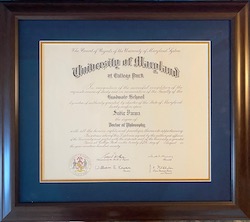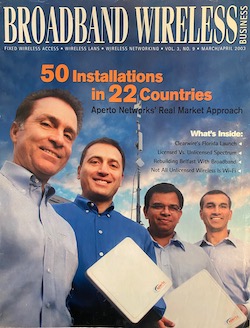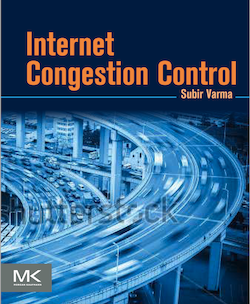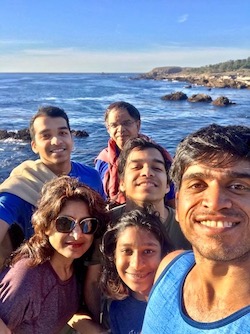Publications
PhD Thesis
Heavy and Light Traffic Approximations for Queues with Synchronization Constraints, University of Maryland, College Park (1990). Thesis Advisor: Armand Makowski
MS Thesis
Some Problems in Queueing Systems with Resequencing, University of Maryland, College Park (1987). Thesis Advisor: Armand Makowski
1985-1994

The publications during the period 1985-1994 were dominated by the papers that arose out of my MS and PhD Thesis work at the University of Maryland. This work was of a heavily theoretical nature, and had to do with Queueing Theory analysis of types of queues called Fork-Join queues and Resequencing queues.
I joined the IBM Networking Systems Division towards the end of 1990, and my subsequent work was in the area of Computer Networking. I initially worked for a software product called VTAM during which my main concern was making this system more efficient and run faster. Subsequently I transferred to the Advanced Technologies group within IBM in which I worked on Traffic Managemernt and QoS issues. This expertise came in very handy for the next stage of my career, when I applied my knowledge of QoS Scheduling Algorithms and Rate Based Traffic Control to the Broadband Access area.
- Queues with Resequencing, Part 1: Structural Properties, S Varma, AM Makowski, Technical Report, University of Maryland, College Park, (1987).
- Queues with Resequencing, Part 2: Heavy Traffic Limits, S Varma, AM Makowski, Technical Report, University of Maryland, College Park, (1990).
- Queues with Resequencing, Part 3: Light Traffic Limits and Interpolation Approximations, S Varma, AM Makowski, Technical Report, University of Maryland, College Park, (1990).
- A Matrix Geometric Solution to a Resequencing Problem, S Varma, Performance Evaluation, Vol 12,Issue 2, (1991).
- Optimal Allocation of Customers in a Two Server Queue with Resequencing, S Varma, IEEE Transactions on Automatic Control, Vol 36, Issue 11, (1991)
- Performance Evaluation of the TIme Stamp Ordering Algorithm in a Distributed Database, S Varma, IEEE Transactions on Parallel and Distributed Systems, Vol. 4, Issue 6, (1993).
- Interpolation approximations for symmetric fork-join queues, S Varma, AM Makowski, Performance Evaluation Vol. 20 (1-3), 245-265, (1994).
- Approximations for Acyclic Fork-Join Networks, S Varma, AM Makowski, Technical Report, University of Maryland, College Park, (1990).
- Heavy Traffic Limits for Fork-Join Queues, S Varma, AM Makowski, Technical Report, University of Maryland, College Park, (1990).
- Comparison of Scheduling Strategies in Multi-Processor Systems, AM Makowski, TK Phillips, S Varma, Technical Report, University of Maryland, College Park, (1991)
- Performance Evaluation of Spin Locks in Multi-Processors, S Varma, IBM Technical Report, (1992).
- A Survey of Performance Issues in Communication Protocol Design and Implementation, S Varma, IBM Technical Report, (1993).
- An Efficient Timer Implementation for HPR, S Varma, B Rajaraman, IBM Technical Report, Also see US Patent 5,838,957, (1994).
- Providing Enhanced QoS Capabilities in BBNS Networks, S Varma, IBM Technical Report, (1994).
- Traffic Flow Regulation to Gaurantee End to End Delay in Packet Swiched Networks, S Varma, IBM Technical Report, (1994), V Peris, L Georgiadis, R Guerin, S Varma, US Patent 5,796,719, (1998).
- An Algorithm for Computing the Burstiness Curve for VBR MPEG-2 Video Sources, S Varma, IBM Technical Report, (1994).
- Computation of the Characteristic Curves for Video Sources, S Varma, IBM Technical Report, (1994).
1995 - 2004

I became interested in Broadband Access in 1995, and made the move to Silicon Valley where most of the action was happening. This was the era of 28.8 kbps modems, and with the Web exploding in popularity, there was an urgent need to increase the speed to bring Internet Access to the home. I initially worked on Cable Modems at one of the early companies in this field called Hybrid Networks. I also become heavily involved in the IEEE802.14 Cable Modem Standards Group during this period. My work at Hybrid culminated in the HAS2000 System for which I designed the upstream Medium Access Control protocol. This was one of the first systems in the Market that enabled both Cable as well as Wireless access at high speeds.
I left Hybrid in 1999 and co-founded a start-up called Aperto Networks which aimed to bring high speed Internet Access to Home and Business users with wireless broadband. Wireless at this time was used mainly for voice, with very poor support for data. The system I designed for Aperto, called PacketWave was successfull in bringing to market a high speed wireless pipe that could compete with wired alternatives such as DSL or Cable Modems. It had one of the most advanced Medium Access Control designs for its time, featuring a sophisticated Scheduler coupled to a Link Adadptation algorithm that was constantly changing link parameters on a per user basis.
- Efficient Algorithms for the Exact Computation of the Loss Curve for Video Sources, C Tryfonas, A Varma, S Varma, Proceedings of the International Teletraffic Congress, Vol. 4, Issue 6, (1999).
- MPEG-2 over ATM: System Design Issues, S Varma, Proceedings of the IEEE COMPCON ‘96, (1996)
- Support for ATM Traffic Classes in HFC Networks, S Varma, Proceedings of the IEEE ICC/SUPERCOMM ‘96, (1996).
- Shared Memory Fabric Architecture for Very High Speed ATM Switches, S Varma, T Daniel, US Patent 5,831,980, (1998).
- Design for an ATM Segmentation and Re-Assembly Processing Unit, T Daniel, D Nattkemper, S Varma, US Patent 5,982,749, (1999).
- Performance and Buffering Requirements of TCP Applications in Asymmetric Networks, S Varma, Proceedings of the IEEE INFOCOM ‘99, (1999).
- A Scheduler for Controlling Multiple Upstream Channels Using a Mixture of Contention and Polling, S Varma, F Enns, US Patent 6,275,497, (2001).
- Aperto MAC Layer Enhancements, S Varma, Aperto Networks Technical Report, (2002).
- MAC Layer Design Proposal to IEEE802.16, S Varma, Proceedings of the IEEE 802.16 Broadband Wireless Working Group, (2001).
- The Aperto Networks Link Scheduler, S Varma, Aperto Networks Technical Report, Also see US Patent App. 0038325, (2002).
- Scheduling on Links with Changing Parameters, S Varma, Aperto Networks Technical Report, Also see US Patent 7,139,251, (2000).
- An Automatic Re-Transmission (ARQ) Scheme for High Speed Point to Multipoint Links, S Varma, Aperto Networks Technical Report, Also see US Patent 7,099,289, (2000).
- Integrated Self-Optimizing, Multi-Parameter and Multi-Variable, Point to Multipoint Communication System, R Majidi-Ahy, J Hakim, S Varma, US Patent 6,654,384, (2003).
- An Algorithm for Dynamic Link Adaptation, S Varma, R Majidi-Ahy, J Hakim, W Wong, Aperto Networks Technical Report, Also see US Patent 6,643,322, (2002).
- Contention State Machine for High Speed Point to Multipoint Networks, S Varma, Aperto Networks Technical Report, (2001).
- Support for Multiple Synchronized Channels Under a Single MAC Layer, S Varma, J Hakim, Aperto Networks Technical Report, Also see US Patent 7,068,639, (2003).
- Co-Channel Interference Management in Next Generation Broadband Wireless Networks, S Varma Proceedings of the WCA, (2001).
- Early Results from Next Generation Broadband Wireless Systems, S Varma, M Tassos, Proceedings of the WCA, (2002).
- WiMAX Rolls Interop Guidelines for 802.16a, S Varma, D Chang, EE Times, (2003).
- 50 Installations in 22 Countries, Cover Story, Broadband Wireless Business Magazine, (2003).
2005 - 2014
The Broadband Wireless industry matured and consolidated after 2005, when the focus shifted to Standards based Products. This spelled the end of the era of startups in this industry. I had a played a role in the IEEE 802.16 Standards Committee while at Aperto, where I helped incorporate parts of the Aperto protocol in the standard. The work of this group was folded into the WiMAX Consortium from 2004 onwards, and WiMAX itself was subsumed into the LTE (or 4G) Cellular Standard by the end of that decade. After Aperto I worked at Sprint for a year, where my focus was on Wireless Broadband deployment issues. After Sprint, I spent most of the following years working on WiMAX and LTE Gateways at a startup called Wichorus.
- A Survey of Technologies for Wireless Gateways, S Varma, Technical Report, (2007).
- Analysis of Architectural Alternatives for Low Cost Infrastructure, S Varma, Technical Report, (2008).
- Performance and Capacity Considerations for Mobile VoIP over WiMAX, S Varma, Technical Report, (2008).
- An Introduction to OpenFlow, S Varma, Technical Report, (2011).
- Comparison of Approaches to Software Defined Networking, S Varma, Technical Report, (2011).
- An LTE Enhanced Packet Core Architecture based on SDN and OpenFlow, S Varma, Technical Report, Also see US Patent 9,173,158, (2012).
- An OpenFlow Based Cellular Backhaul Network, S Varma, Technical Report, (2013).
2015 - Present

This has been a decade of Reading, Writing and Teaching. I took leave of the Networking Industry at the start of the decade, my book on Internet Congestion Control was a fond farewell to this phase of my life. In this book I wrote about a part of Networking technology that I loved and had ocassion to often use in the preceding twenty years.
It turned out that this was a good time to change fields, since the area of Neural Networks was in the process of being raised out of the dead by a new technology called Deep Learning. There were enough connections between Deep Learning and my legacy knowledge of probability and statistics, to decide that this was the right field to start becoming familiar with. After spending about a year educating myself (online courses came in very handy), I wrote a book on the topic and also started teaching the subject at Santa Clara University. A slight twist in this story came during pandemic year of 2020, when I launched a Quant Hedge Fund using the knowledge I had gained in the Artificial Intelligence area.
- Internet Congestion Control, S Varma, Morgan Kaufmann/Elsevier, 2015.
- Deep Learning, S Varma, SR Das, Online Book, (2022).
- Dynamic Goals Based Wealth Management Using Reinforcement Learning, SR Das, S Varma, Journal of Investement Management, Vol. 18, No. 2, (2020).
